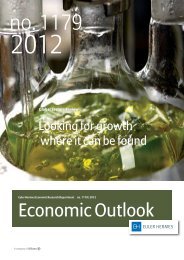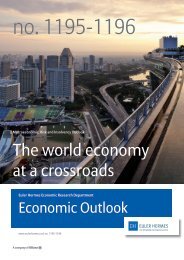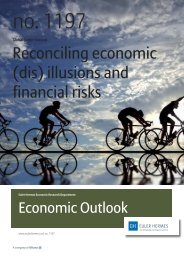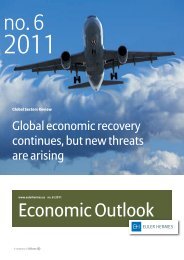Reindustrialization in USA - Euler Hermes
Reindustrialization in USA - Euler Hermes
Reindustrialization in USA - Euler Hermes
Create successful ePaper yourself
Turn your PDF publications into a flip-book with our unique Google optimized e-Paper software.
Economic Outlook n° 1187 | Special Report | The <strong>Re<strong>in</strong>dustrialization</strong> of the United States<strong>Euler</strong> <strong>Hermes</strong>EditorialAn alignment of the stars?With the post-presidential election fever now gone, the immediate shift of theU.S. focus is squarely on the economy. Surely, the road to recovery looks likethe Labors of Hercules. Of course no economic environment will ever be perfect, butthe current uncerta<strong>in</strong>ty surround<strong>in</strong>g the fiscal situation and the ongo<strong>in</strong>g debt crisis <strong>in</strong>Europe are the two largest headw<strong>in</strong>ds currently affect<strong>in</strong>g the U.S. economy. Beyond thetumult <strong>in</strong> the short run, there are some positive macro- and micro-economic factorsthat have caused us to look more thoroughly to what the ‘new normal’ could look like forthe U.S. Here beg<strong>in</strong>s a quest to better understand what underly<strong>in</strong>g trends and dramaticregime changes may support a robust long-term growth <strong>in</strong> the U.S.The potential key to America’s long-term growth lies <strong>in</strong> the very heart of the country, itsmanufactur<strong>in</strong>g sector. Bullied throughout the last decade, its resilience and malleability,further tested by the most too recent crisis, may actually demonstrate why it nowappears to be the backbone of the U.S. recovery. There are several determ<strong>in</strong>ants to thisbold assumption which we analyze <strong>in</strong> this report:• unit labor costs are among the lowest <strong>in</strong> the <strong>in</strong>dustrialized world;• energy costs are low thanks to the gas bonanza;• the cost of capital is very low given the Fed’s ultra-accommodativemonetary policy;• the weak dollar makes U.S. exports very competitive <strong>in</strong> the majority of U.S.export markets; and• the hous<strong>in</strong>g market is slowly rebound<strong>in</strong>g.If you add to this a conducive policy environment and the def<strong>in</strong>ite commitment tocont<strong>in</strong>ue to improve it, there are better days ahead for the U.S. and its private sector.After the perfect storm (the commodity, f<strong>in</strong>ancial and jobs crises), now would be thetime for an alignment of the stars. Manufactur<strong>in</strong>g could lead the U.S. economy out ofimmobilism, and is poised to be a major contributor go<strong>in</strong>g forward.What needs to be done to ma<strong>in</strong>ta<strong>in</strong> the momentum? The private sector <strong>in</strong> the U.S.cont<strong>in</strong>ues to be relatively self-re<strong>in</strong>vent<strong>in</strong>g without much <strong>in</strong>tervention. But like a goodgardener, the government may want to occasionally water the flowers. In this report,we outl<strong>in</strong>e several actions necessary to catalyze this rebirth.Of course, we will cont<strong>in</strong>ue to monitor this re<strong>in</strong>dustrialization phenomenon andaccompany our clients on the still bumpy road ahead. It is all about good ‘ol production,key <strong>in</strong>dustries such as the energy and chemicals sector and the agri-food bus<strong>in</strong>esses,and growth markets: the South, Texas, and California. If supported, the real economyshould <strong>in</strong>deed rega<strong>in</strong> its strength. _ Ludovic Subran3












